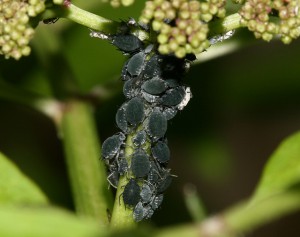Density of pest insects determines harm from neonicotinoids to beneficial predators
Neonicotinoid pesticides have been criticized for the harm they may cause to non-herbivore insects such as bees. Now, a growing body of literature suggests that their use may also indirectly harm beneficial insects that prey on insect pests. One recent study published in the scientific journal Crop Protection found that when wheat was treated with neonicotinoids, lady beetles—which are predators to aphids—were negatively impacted, and to what extent depended on the density of the aphids on the wheat plant. Two experiments were performed. In the first experiment, wheat plants were treated with high and low dose drenching of thiamethoxam and then used to rear aphids for 24 hours. These aphids were then fed to their natural predator, the ladybeetle larvae. Young ladybeetle larvae at the second instar had significantly higher mortality after eating aphids reared on neonicotinoid-treated wheat than those that consumed aphids from untreated wheat. In the second experiment, researchers fed ladybeetle larvae aphids that were feeding on neonicotinoid wheat in different densities. They found that when there were fewer aphids feeding on a single wheat plant, each aphid consumed a greater amount of pesticide. When the density of aphids per plant increased, the amount of pesticide present in each aphid decreased. Accordingly, ladybeetle second instar larva consuming aphids that had been feeding in low densities were most negatively affected, exhibiting slower walking speeds than the instar larvae that consumed aphids feeding at high densities. More studies are needed to determine if these interactions occur in the field, but future non-target risk assessments should include potential harm to beneficial insects.




